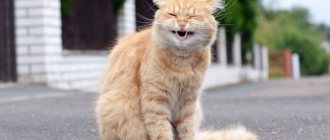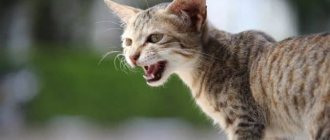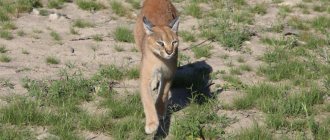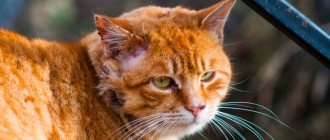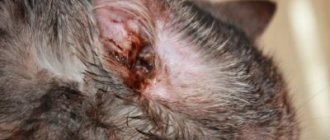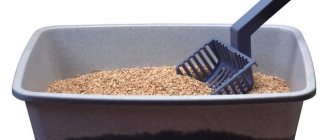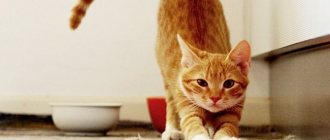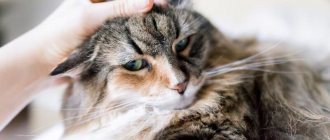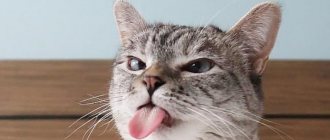It’s nice to communicate and play with cats: they are affectionate, fluffy, they like to bask in a person’s arms, purring... But sometimes our pets disturb us by making sounds that are not entirely “understandable”. Sometimes animals cough, sneeze, and sniffle. But all this is understandable. The cat could have caught a cold, or there might have been debris in his nose. But what if the cat grunts when breathing? Agree, it’s much more common to hear such sounds from a piglet, but not at all from your favorite furry “beast.”
Why this can happen: natural predisposition
If you are the owner of an “English” or a Persian cat, then you will most likely have to come to terms with his “oddities”. The fact is that animals of these breeds belong to the so-called brachycephalic varieties. This is the “scientific” name for mammals that have a shortened head with a characteristic “flat” muzzle.
In the process of breeding such animals, breeders encountered a lot of difficulties. So, the same Persians have a lot of genetic anomalies, many of which are tied to the genome, which provides these animals with a shortened full face of the skull. Whatever one may say, from a natural point of view such a structure is nonsense. In particular, all cats of these varieties are extremely unstable to the effects of very high and low temperatures: the air simply does not have time to warm up or, on the contrary, cool down in their nasal cavity.
In winter, Persians, Britons and cats similar to them constantly catch colds (they should not be allowed outside at all when the ambient temperature drops below 10° Celsius). In the summer, it’s hard and difficult for them to breathe in the heat - hence the “grunting”. Because of this, your pet regularly sneezes when he gets into a dusty room: his respiratory organs simply do not have time to filter everything. But there may be more to it than that.
The problem also lies in the structure of the soft tissues of their palate. Over time, especially in old pets, it can simply “sag,” thereby blocking the normal flow of air. Because of this, the animal becomes even more like a pig. In principle, there is no particular problem here, but... if the grunting becomes incessant, and your cat cannot sleep normally due to “heroic” snoring, we strongly advise you to take him to the veterinarian. It is quite possible that he will need surgery to correct the structure of the soft palate. During the intervention, the surgeon will cut off the “extra” parts that interfere with the normal passage of air. Another sign that “clearly hints” at the need for such a procedure is vomiting, which occurs with particularly strong “grunting”. But there are other causes of grunting breathing, many of which are not so “harmless”.
Pharyngeal (pharyngeal) reflex
This condition is also called “paroxysmal breathing” or “reverse sneezing.” It is not a disease, but it looks quite alarming and unusual.
Paroxysmal breathing is recorded not only in cats, but also in dogs and people.
According to felinologists, its cause is irritation of the soft palate, resulting in a kind of spasm. At the same time, the animal rests on its forelimbs, stretches its neck, arches its back and produces sounds reminiscent of a noisy short breath, sneezing, coughing and grunting at the same time.
Causes. The condition can be provoked by:
- emotional state and stress;
- quickly eating or drinking liquids;
- inhalation of cigarette smoke, dust, pollen and other allergens;
- pungent odors;
- respiratory infections;
- squeezing the throat with a harness.
Progression and diagnosis. Usually the cat copes with an attack of reverse sneezing on its own, however, if the respiratory abnormality becomes more and more obvious, then perhaps the animal really is sick. In particular, a gradual increase in symptoms is caused by neoplasms growing in one or another part of the respiratory tract. The owner will be able to independently diagnose them only if the tumors become too large and manifest themselves externally, or enter the decay phase and begin to bleed. Ultrasound diagnostics and x-rays will help dispel all doubts.
"Parasitic" problems
It is known that finding a cat that has not had helminths in its life is a task that is almost impossible in practice. It is extremely easy to “pick up” a parasite for a cat - he does not wash his paws with soap. On the contrary, our clean pets constantly lick their fur, to which anything can stick. For example, parasite eggs. Professional veterinarians generally recommend treating their pets with antiparasitic agents at least once a quarter, since otherwise problems cannot be avoided. Moreover, this must be done at intervals of two weeks...
Allergic manifestations
Allergies are common among tailed pets. An allergen entering the body during breathing provokes an immune system reaction characterized by irritation and inflammation of epithelial cells, swelling of the mucous membrane of the respiratory tract and accumulation of exudate in the bronchi. As a result, the cat:
- has difficulty breathing through the nose;
- breathes through an open mouth;
- makes wheezing, grunting and coughing sounds.
Allergens:
- dust;
- household chemicals;
- chemical preparations for ectoparasites;
- tobacco smoke;
- aerosols and any flavored perfumes;
- cat litter;
- paint and varnish products;
- flower pollen.
Associated symptoms. Difficulty breathing due to allergies is accompanied by:
- sneezing and watery discharge from the nasal passages;
- redness of the eyes and watery eyes;
- itching and the need to constantly rub the face with your paws;
- redness in the throat, dry cough and difficulty swallowing;
- skin and coat problems.
Nature of manifestations. The severity of respiratory allergic manifestations can vary and may include:
- allergic laryngitis and tracheitis;
- allergic bronchitis;
- bronchial AS src=»https://porodakoshki.ru/wp-content/uploads/2019/10/Virusnye-zabolevaniya-dyhatelnyh-putej-e1571507833171.jpg» class=»aligncenter» width=»600″ height=»338″ [/img]
In the latter case, the animal suffers from episodic attacks of suffocation caused by bronchospasm, swelling of the respiratory tract mucosa and excessive mucus production by the bronchial epithelium. At such a moment, it seems that the animal cannot take a breath, breathing with wheezing and whistling.
Asthma most often affects adult cats aged 2 years and older.
Methods of therapy. To relieve allergy symptoms, the veterinarian prescribes antihistamines and corticosteroids, and for asthma, special aerosols. An allergic cat must be kept at a comfortable temperature with humidification, preventing the inhalation of dust, tobacco smoke and other substances hazardous to it.
Inflammation of the trachea
It is also “tracheitis”. It occurs due to many reasons, with the leading one being the effect of too low temperatures. Your cat, just like a person, can get very cold in frosty or chilly weather. Hypothermia contributes to the deterioration of the animal’s body’s defenses, as a result of which the rapid growth and development of pathogenic and conditionally pathogenic microflora begins. The logical result is that the animal breathes poorly through its nose, making grunting, wheezing and wheezing sounds. But the main symptom of tracheitis is cough.
Helminthiasis
An animal carrying parasitic worms can make unusual grunting sounds.
Toxocara. The development cycle of the Toxocara nematode begins with the cat swallowing food infested with larvae or eating the intermediate host of the parasite, which is:
- mouse;
- rat;
- bird;
- insect.
Development in the body . In the intestine, the larva actively invades the blood vessel through the epithelial wall in order to enter the lungs with the bloodstream. Young parasites feed on the blood and tissues of the airways, causing severe irritation, difficult wheezing breathing and a reflex cough.
The damaging effect leads to the attachment of pathogenic bacteria that increase inflammation. With a cough, some of the larvae enter the oral cavity and are swallowed again, growing in the intestines into a mature worm. During the period of migration of larvae into the digestive tract, the cat may experience the urge to vomit.
Hookworm. Hookworm larvae cause hookworm disease by entering the cat’s body in several ways:
- simultaneously with food and water;
- when self-licking;
- through the skin with subsequent penetration into the bloodstream;
- when eating infected rodents.
Development. The path of larvae that have penetrated through the skin into the blood lies in the respiratory tract, and then, when coughing, into the oral cavity.
After 3 weeks, swallowed parasite embryos grow in the intestines into adult individuals that feed on the blood of the host animal.
Clinical picture of helminthic infestation. Infection with helminths in a cat is indicated by:
- poor appetite and weight loss;
- apathetic behavior;
- disruptions in the gastrointestinal tract;
- increase in abdominal volume;
- the appearance of mucus and blood in feces;
- unkempt appearance, poor coat;
- constant discharge from the eyes;
- pallor of the mucous membranes in the mouth.
Diagnosis and treatment. The diagnosis is based on laboratory tests of blood and feces. Having determined the type of helminth, anthelmintic drugs are prescribed in the required dose and, possibly, with repeated use.
Also watch the video of a cat breathing with wheezing:
Foreign bodies
Just like a person, a cat may well choke while eating. Sometimes a couple of minutes are enough for him to cough properly, but sometimes an unsuccessfully swallowed piece of food can end up in the lumen of the respiratory tract. This is fraught not only with the development of “grunting” breathing, but also with something more serious, including the possibility of death from suffocation.
If your cat suddenly starts grunting, wheezing and coughing immediately after eating, call the vet immediately! Even in mild cases, when a foreign body only partially blocks the lumen, all visible mucous membranes of the pet quickly turn blue and become engorged with blood . The result is death from suffocation or severe pulmonary edema . Of course, you can try to remove the foreign body yourself, but in cases where you do not have the appropriate veterinary or medical experience, you should not do this. You will only aggravate the pathological process and possibly injure the animal.
Unfortunately, pieces of unsuccessfully swallowed food are not the worst thing. A similar clinical picture can be caused by tumors, not only benign, but also malignant . Grunting in such cases develops gradually. Neoplasms, as a rule, take a long time to grow, and therefore owners may not attach much importance to the pet’s strange behavior.
Thus, all the strange sounds that your cat begins to make are a reason for an immediate visit to the clinic. Perhaps in this way you will save his health and even his life.
Foreign object
When a cat coughs as if it was choking, instead of panicking, it is advised to determine the time and duration of the reflex and assess the pet’s condition. Sometimes an animal greedily gobbles up the food it likes, and food particles stick to the roof of the mouth. To get rid of the problem, the cat sticks out its tongue, coughs up small particles of food that come out along with the vomit, and stops stretching its neck.
The owner should be wary when the animal tries to open its mouth wide and rubs it with its paw, since the reason why the cat coughs, as if choking, is:
- blade of grass or sliver;
- filler or bead;
- a piece of rope;
- toy part;
- bone from fish, chicken.
An animal that makes hoarse sounds without belching should be picked up, and the mouth should be inspected by opening its mouth. If the cat owner cannot remove the object on his own, he should contact a veterinarian.
Best answer
Flori 7 (45812) 3 47 184 10 years
Bop4yH 6 (10917) 3 32 92 10 years
The wires will just fucking end, otherwise it’s a waste of money
genarjok999 5 (3132) 1 3 12 10 years
naverna u tvoej kowki estj ekstrasensornie sposobni vlijatj na okruzajuwie elekrto tehni4ikie obarudovanija :D:D:D
naH_CTaLLIek 5 (3149) 2 10 17 10 years
The cat produces a special background house magic. The further it is from the speakers, the weaker the background. Well, or something like that!
naH_CTaLLIek 5 (3149) 2 10 17 10 years
Should you worry when your newborn makes noises in his sleep?
Should I be concerned when newborns make noises in their sleep? What should you pay attention to when it comes to sleep issues?
A newborn baby does not have the same need for sleep as an older baby. It is very important in advance, long before the birth of a new person, to understand the baby’s sleep pattern and adjust the daily routine in accordance with it.
Do's and Don'ts?
Under no circumstances should you listen to other people's advice. It is better to read and listen to people who really understand raising children as much as possible. Everyone who is directly or indirectly related to a newborn child has their own opinion on how to solve the baby’s sleep problem.
Why are these tips dangerous for young parents? They will negatively affect parenting skills. The result will be a negative impact on the infant's development. Therefore, it is very important to be well informed in all matters relating to children's sleep. This will prevent others from raising any doubts about the decision made.
Once all the facts related to this issue have been worked out, it will be possible to confidently respond to everyone who gives false advice. Where can I find out the necessary facts about this problem? In magazines and books on relevant topics. You can also attend classes in a special support group. They will help you understand the essence of the problem and make the right decision.
A Brief Introduction to Newborn Sleep Biology and Sounds
No one can put him to sleep when he doesn't want to, or wake him up when he wants to sleep. It would be very convenient to put your child to bed at a time convenient for you and not hear a single sound from him. It's complicated. If we are talking about a crumb, this is impossible. Babies should be fed every 2-4 hours, sometimes even more often. Therefore, frequent awakenings in infants are not strange or unusual.
Iridescent purring and squeaking
Sounds similar to the chirping of birds are acquired by kittens from early childhood. This is a much more insistent demand than meowing. The mother cat uses them to let her kittens know that they should look at her or follow her. As the cat matures, it will squeak and purr loudly, forcing you to pay attention to something extremely important to it. Squeaks and iridescent purrs can also indicate that your cat is excited.
Has a strong marriage cracked? Iker Casillas divorces wife Sara Carbonero
What offense did Alexandra Ursulyak not forgive her first husband and filed for divorce?
A little butter and the taste is completely different. Bright vegetable side dish
The mechanism of purring in cats
Zoologists studying the process of purring put forward three hypotheses regarding the mechanism of rumbling:
- Cats purr using false vocal cords;
- Rumbling occurs due to air vibrations in the sinuses;
- Rumbling occurs in the lungs when air is exhaled.
The vocal cord hypothesis suggests that when a cat opens its mouth, it makes a meow, and when its mouth is closed, air vibrates in the larynx and creates a purr.
Other experts believe that when a cat experiences positive emotions, its blood pressure increases. Due to this, vibration appears in the chest and is transmitted to the sinuses, resulting in purring.
Still others believe that the rumbling is generated by the vibration of the intercostal and diaphragmatic muscles during inhalation and exhalation. Which part of the feline brain is responsible for purring is still unknown.
